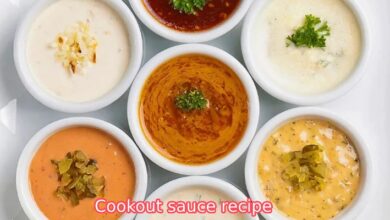What does cooked salmon look like
Cooked salmon is a sight to behold with its vibrant and appetizing appearance. The flesh of the salmon turns from a translucent pink to a delicate, opaque coral color. The surface of the fish becomes flaky and tender, easily separating into succulent flakes with a gentle touch. The cooked salmon retains its natural oils, giving it a glistening sheen. The aroma of the fish is enticing, with a slightly smoky and buttery fragrance. Whether grilled, baked, or pan-seared, cooked salmon is a visual delight that promises a delectable and satisfying dining experience.
Is pink inside salmon okay?

Salmon can be perfectly cooked with a pink middle. The pink hue in cooked salmon is derived from astaxanthin, a natural pigment present in various seafood, including salmon. Unlike other pigments, astaxanthin retains its color even at high cooking temperatures. This pigment is also responsible for the vibrant red color observed in cooked shrimp and lobster.
How long does it take to cook salmon?

Salmon can be perfectly cooked in 20 to 25 minutes at 350°F in an oven. Alternatively, you can use an air fryer or grill for quicker cooking. Once cooked, the salmon should be moist and easily flakeable with a fork. To enhance its flavor, you can choose to glaze or marinate it.
Is it OK to eat salmon rare?
Raw salmon can contain bacteria, parasites, and other pathogens that can be harmful to human health. These pathogens can either occur naturally in the fish’s surroundings or be a result of mishandling. To ensure safety, it is recommended to cook salmon to an internal temperature of 145F (63C) as this kills bacteria and parasites. However, consuming raw salmon poses a risk of infection.
Should cooked salmon be pale?

To determine if your salmon is undercooked, observe a light pink and red color in the thickest part. The texture should be soft and slimy. As the salmon cooks, it will transition from a translucent red color to an opaque pink color. After cooking for approximately 6-8 minutes, press down on the top of the fillet with a fork or finger to check for doneness.
If the salmon still appears translucent or raw, it requires further cooking. Continue cooking for a few more minutes. Once cooked, the salmon should have a pink and moist texture. If the salmon has turned white or flaky, it has been overcooked.
Is it OK if salmon is a little undercooked?
Eating undercooked salmon is not safe as it can lead to foodborne illnesses like salmonellosis, norovirus, and Vibrio infections. These illnesses can cause symptoms such as diarrhea, fever, abdominal cramps, nausea, vomiting, and diarrhea.
Salmonella, a bacteria commonly found in raw or undercooked salmon, can cause symptoms like diarrhea, fever, and abdominal cramps. Norovirus, another virus found in raw or undercooked seafood including salmon, can cause symptoms like nausea, vomiting, and diarrhea.
Raw or undercooked salmon may also contain Vibrio bacteria, which can cause infections like Vibrio parahaemolyticus and Vibrio vulnificus. These infections can lead to symptoms such as fever, vomiting, and diarrhea. In severe cases, they can even result in blood infections and other complications.
To ensure the safety of salmon, it should be cooked to an internal temperature of 145F (63C). The flesh should be opaque and easily flaked with a fork. Proper storage and handling of salmon are also crucial in preventing the growth of harmful bacteria.
How long should I cook salmon?
How to Bake Salmon to Perfection
Preparation: 5 minutes
Cooking: 15 minutes
Total Time: 25 minutes
Servings: 4
Ingredients:
– 1 1/2 pounds salmon (either a single portion side or 4 6-ounce fillet portions)
– 2 tablespoons extra virgin olive oil
– Seasonings of your choice (such as salt, pepper, seafood seasoning, or Cajun seasoning)
– Fresh herbs and lemon wedges (optional for serving)
Instructions:
1. Preheat your oven to 400 degrees F and place a rack in the center. Line a 9×13-inch baking dish with parchment paper.
2. Pat the salmon dry and arrange it in the center of the baking dish. If using fillet portions, make sure they do not touch.
3. Drizzle the salmon with the olive oil and sprinkle on your desired seasonings.
4. Bake the salmon at 400 degrees F for 11 to 14 minutes for 6-ounce fillets, or 15 to 18 minutes for a single side. Use an instant-read thermometer to check that the thickest part of the salmon registers 135 degrees F.
5. Remove the salmon from the oven and let it rest for 5 minutes.
6. Serve the salmon warm, optionally garnished with fresh herbs and a squeeze of lemon.
Enjoy perfectly cooked salmon every time with this simple and delicious recipe!
Why is my cooked salmon white not pink?
By Terry Thompson
King salmon, also known as Chinook salmon, are highly sought after by sport anglers and are considered one of the finest delicacies for the dinner table. These magnificent fish can have differently colored flesh, including red, white, or marbled. Each color has its own unique texture and flavor, making them all a treasured treat for those who love to eat wild salmon.
Most king salmon have a flesh color that ranges from reddish orange to pinkish-red. However, the white-fleshed king salmon, also known as ivory king, was once considered less desirable but is now highly sought after and commands a premium price. Catching a white king is rare and depends on luck.
Despite the difference in flesh color, white kings and red kings are the same species of fish. The variation in color comes from their genetically-determined ability to metabolize pigments from their food. Carotenoids, which are found in their diet of shrimp, krill, and crabs, give the fish their distinct color. White-fleshed king salmon lack the genetic ability to break down these pigments, resulting in their ivory color. Marbled flesh, on the other hand, occurs when the fish have a limited ability to metabolize carotenoids, creating a marbled appearance.
The trait for white flesh is passed on from adult spawners to their offspring. It is estimated that approximately 5 percent of the king salmon population in the region from the Fraser River in British Columbia to the Chilkat River in Southeast Alaska carry the recessive trait for white flesh. However, some river systems within the Fraser River watershed have nearly 100 percent white-fleshed kings.
While some people claim to be able to predict the flesh color of a king salmon based on its behavior when caught, the only sure way to determine the color is by cleaning the fish. Both red and white kings have similar health benefits, as they are rich in healthy lipids, moisture, protein, and omega-3 fatty acids.
Seafood chefs praise the melt-in-your-mouth flavor of white king salmon, but they don’t prepare them much differently than red-fleshed fish. Due to their limited and unpredictable supply, white and marbled kings are more expensive when dining out.
If you want to join in the taste testing research on king salmon, consider getting a fishing license and enjoying sport fishing along the Pacific coast. Who knows, you might be lucky enough to bring home a beautiful white king. Regardless of your fishing trip’s outcome, remember to enjoy the day and continue supporting sustainable wild Alaska salmon.
Conclusion
Conclusion:
In conclusion, it is generally safe to consume salmon that is slightly undercooked, as long as it reaches a minimum internal temperature of 145°F (63°C). However, it is important to note that individuals with compromised immune systems, pregnant women, and young children should avoid consuming undercooked fish due to the risk of foodborne illnesses.
When it comes to cooking salmon, the cooking time will vary depending on the method used and the thickness of the fillet. As a general guideline, salmon should be cooked for about 10 minutes per inch of thickness. However, it is crucial to monitor the cooking process closely to prevent overcooking, which can result in a dry and less flavorful fish.
The cooking time for salmon can range from 10 to 20 minutes, depending on the desired level of doneness and the cooking method employed. Grilling and broiling are quicker methods, while baking and poaching may take a bit longer. It is essential to use a food thermometer to ensure the salmon reaches the recommended internal temperature of 145°F (63°C) for optimal safety and taste.
While some individuals enjoy eating salmon rare, it is generally recommended to cook it thoroughly to minimize the risk of foodborne illnesses. Consuming raw or undercooked salmon can expose you to harmful bacteria and parasites, such as salmonella and anisakis. Therefore, it is advisable to cook salmon until it is opaque and flakes easily with a fork.
If your cooked salmon appears white instead of pink, it could be due to overcooking. Overcooked salmon tends to lose its natural pink color and become dry and less flavorful. To maintain the pink color, it is crucial to cook salmon just until it reaches the recommended internal temperature and avoid overcooking it.
In conclusion, cooked salmon should have a pink hue, indicating that it is cooked to perfection. However, it is important to note that the color of salmon can vary depending on the species and diet of the fish. As long as the salmon is cooked to the recommended internal temperature and has a moist and flaky texture, the color variation should not be a cause for concern.
Sources Link
https://explore.typhur.com/how-to-tell-if-salmon-is-cooked
https://aksalmonco.com/blogs/learn/is-it-safe-to-eat-undercooked-salmon
https://www.wellplated.com/baked-salmon-temperature-guide/
https://www.halfscratched.com/how-long-to-bake-salmon-at-350/
https://www.healthline.com/nutrition/can-you-eat-raw-salmon
https://www.adfg.alaska.gov/index.cfm?adfg=wildlifenews.view_article&articles_id=738
https://pacificfishgrill.com/blog/what-color-should-cooked-salmon-be-complete-guide-to-cooked-salmon-color/
You are watching: What does cooked salmon look like


